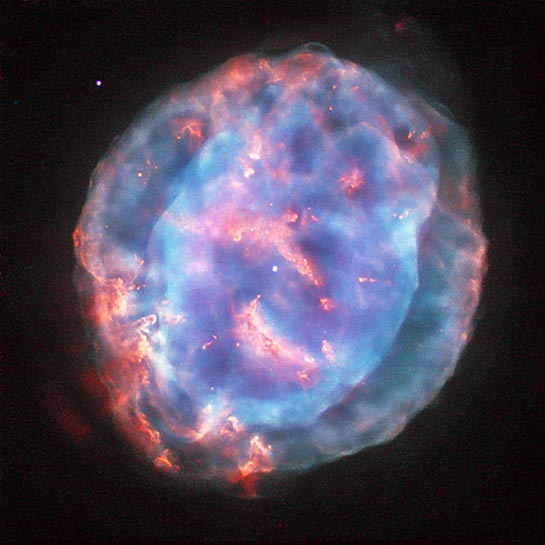
Planetary Nebula
RA:19hr 43m 58.02s Dec -14° 9' 13.71"
Sagittarius
6000 light years
0.54 x 0.55 arcminutes
North is 32.9° right of vertical
ESA/Hubble & NASA, Ack: Judy Schmidt
August 3, 2015
1998 image: N9811
ABOUT THIS IMAGE:
This colorful bubble is a planetary nebula called NGC 6818, also known as the Little Gem Nebula. It is located in the constellation of Sagittarius (The Archer), roughly 6000 light-years away from us. The rich glow of the cloud is just over half a light-year across — humongous compared to its tiny central star — but still a little gem on a cosmic scale.
When stars like the Sun enter retirement, they shed their outer layers into space to create glowing clouds of gas called planetary nebulae. This ejection of mass is uneven, and planetary nebulae can have very complex shapes. NGC 6818 shows knotty filament-like structures and distinct layers of material, with a bright and enclosed central bubble surrounded by a larger, more diffuse cloud.
Scientists believe that the stellar wind from the central star propels the outflowing material, sculpting the elongated shape of NGC 6818. As this fast wind smashes through the slower-moving cloud it creates particularly bright blowouts at the bubble’s outer layers.
Hubble
previously imaged this nebula back in 1997 with its Wide Field Planetary
Camera 2, using a mix of filters that highlighted emission from ionized
oxygen and hydrogen (opo9811h). This image, while from the same camera,
uses different filters to reveal a different view of the nebula. A version
of the image was submitted to the Hubble’s Hidden Treasures image
processing competition by contestant Judy Schmidt.